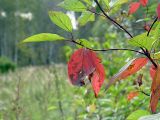
Ветвь. Москва, Кузьминский лесопарк. 21.09.2003.
The marker on the map does not indicate the exact coordinates of the plant or lichen.
The marker does only indicate the conditional center of the terrain ("geographic point") where the photo was taken.
Open mapSee also:
Discussion (4)
All photos of taxon (317)
Code of link to photo
| Create: | HTML or BBCode with preview or HTML or BBCode with image compressed to a given width |
| Code for linking on the web: | |
| This is how it will look: |  Swida alba on the site «Plantarium» |
Text to cite the page
Гуменюк В.И. 2009. Изображение Swida alba (L.) Opiz // Плантариум. Растения и лишайники России и сопредельных стран: открытый онлайн атлас и определитель растений. [Электронный ресурс] URL: https://www.plantarium.ru/page/image/id/9913.html (дата обращения: 20.02.2025).
Гуменюк В.И. 2009. Image of Swida alba (L.) Opiz // Plantarium. Plants and lichens of Russia and neighboring countries: open online galleries and plant identification guide. URL: https://www.plantarium.ru/lang/en/page/image/id/9913.html (accessed on 20 Feb 2025).
Views: 1132Discussion
| Наталия Шульц | Swida alba? |
| Виталий Гуменюк | Точно, она. Вспомнил - на кустах были белые ягоды. |
| Наталья Гудкова | С белыми ягодами может быть и Swida sericea, в культуре она распространена очень широко. |
| Сергей Майоров | Cornus sericea is very similar to C. alba. These two taxa are in recent floras most often treated as separate species rather than subspecies, being vicariant in north temperate to subarctic Asia and America, respectively, with no zone of contact. There is some confusion about the differentiating characters. The indumentum on the lower leaf surface is sometimes claimed to differ, but both taxa are fairly densely hairy, with appressed medifixed hairs, sometimes with a few unbranched hairs among them. The shape of leaves differ, although there is much overlap; C. sericea leaves may be considerably larger and are more distinctly acuminate, often tapering into a long apex. The length of the calyx teeth also gives some guidance. The most reliable character, besides the mode of growth, is the shape of the fruit stones (see fig.), easy to observe in herbarium specimens with dried-up fruits. This means, however, that much of the herbarium material is not possible to determine with full certainty. |